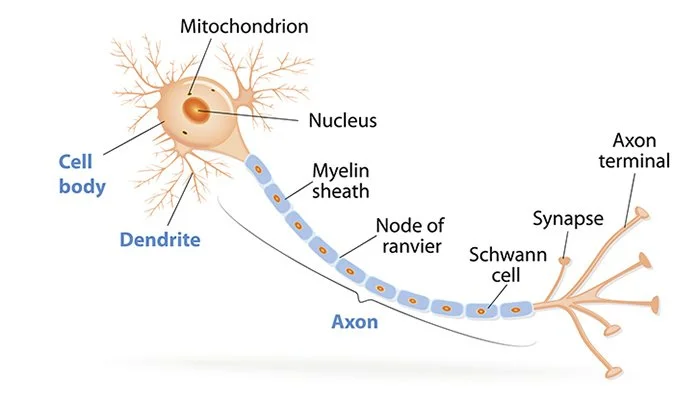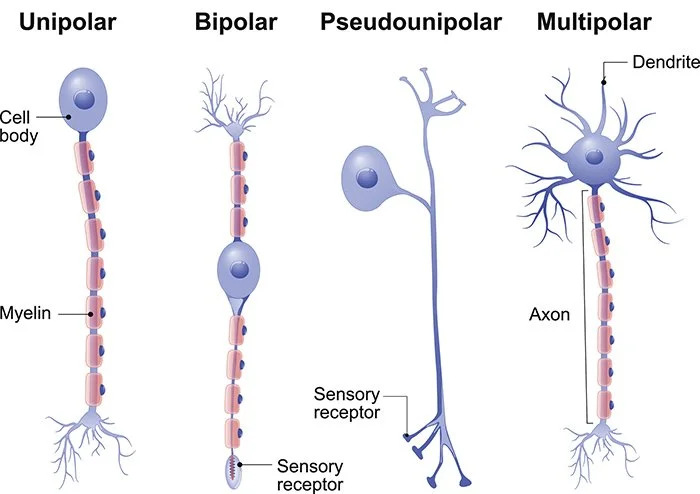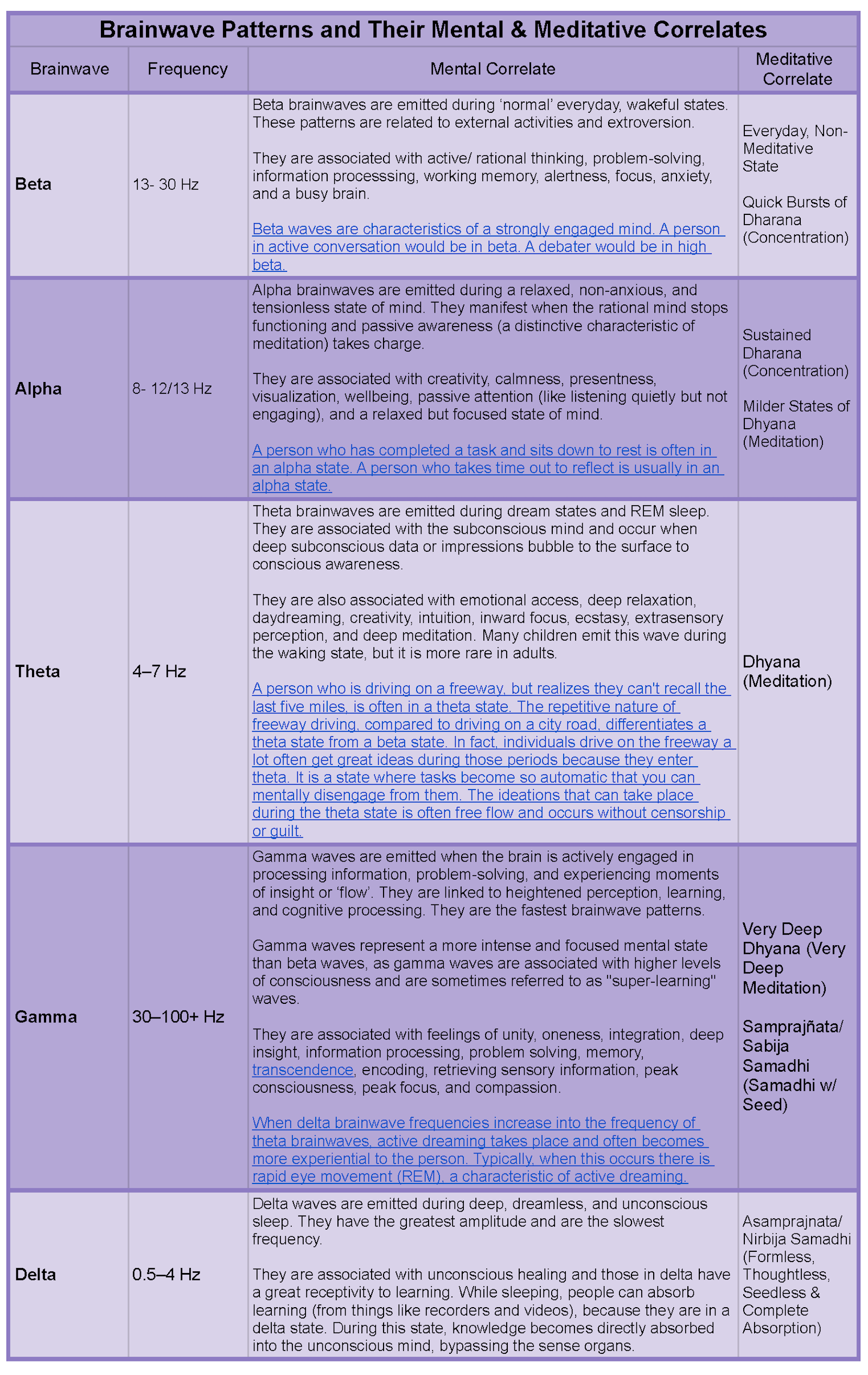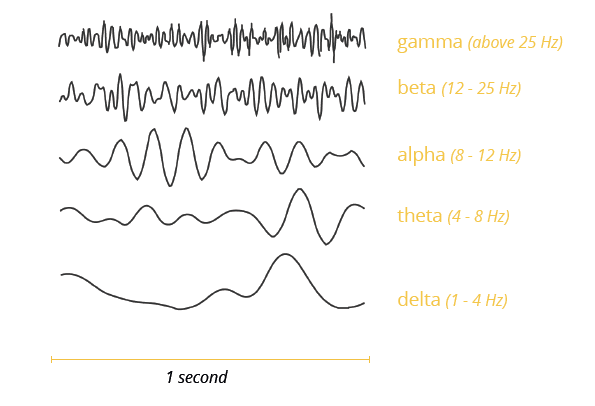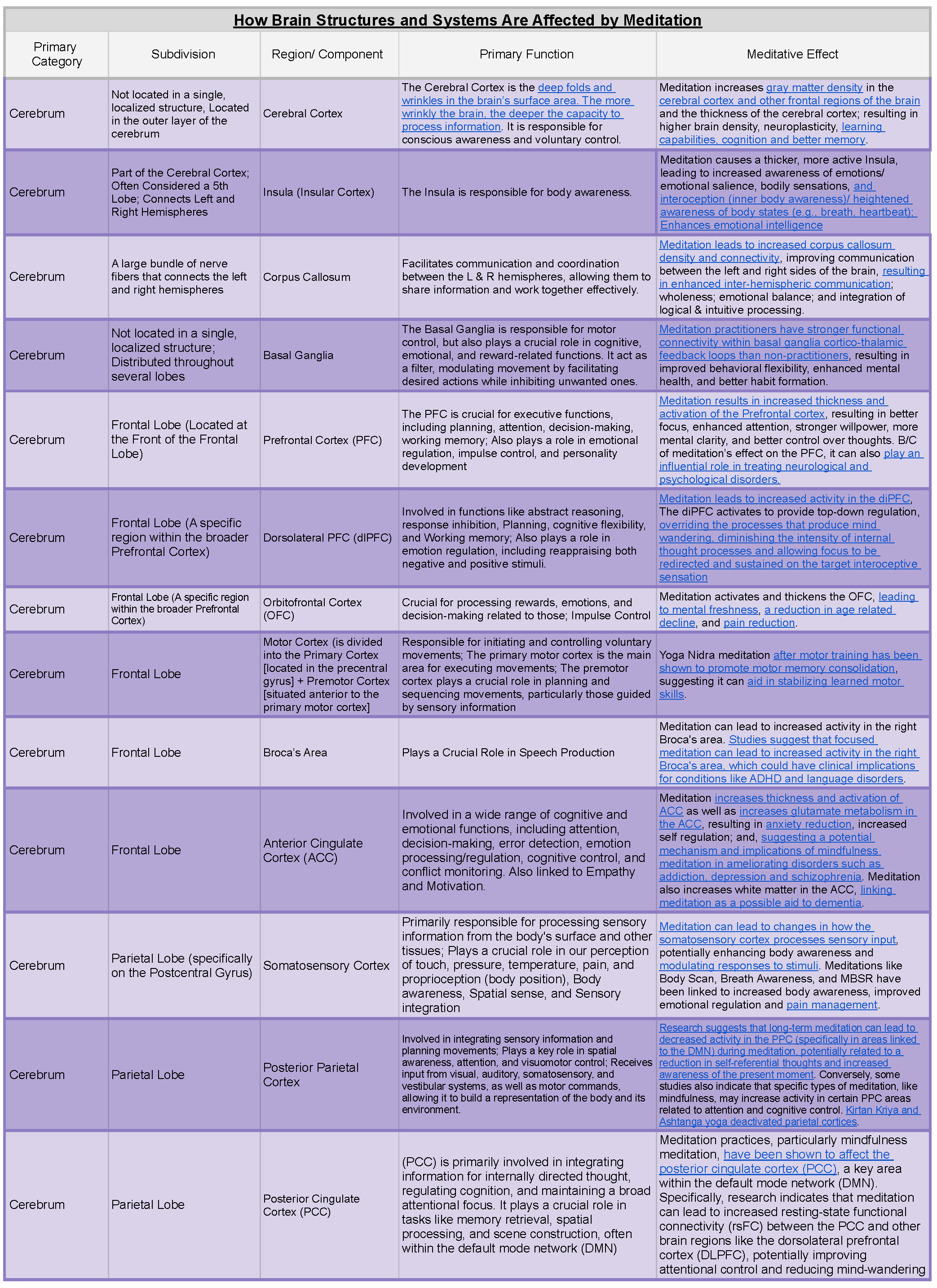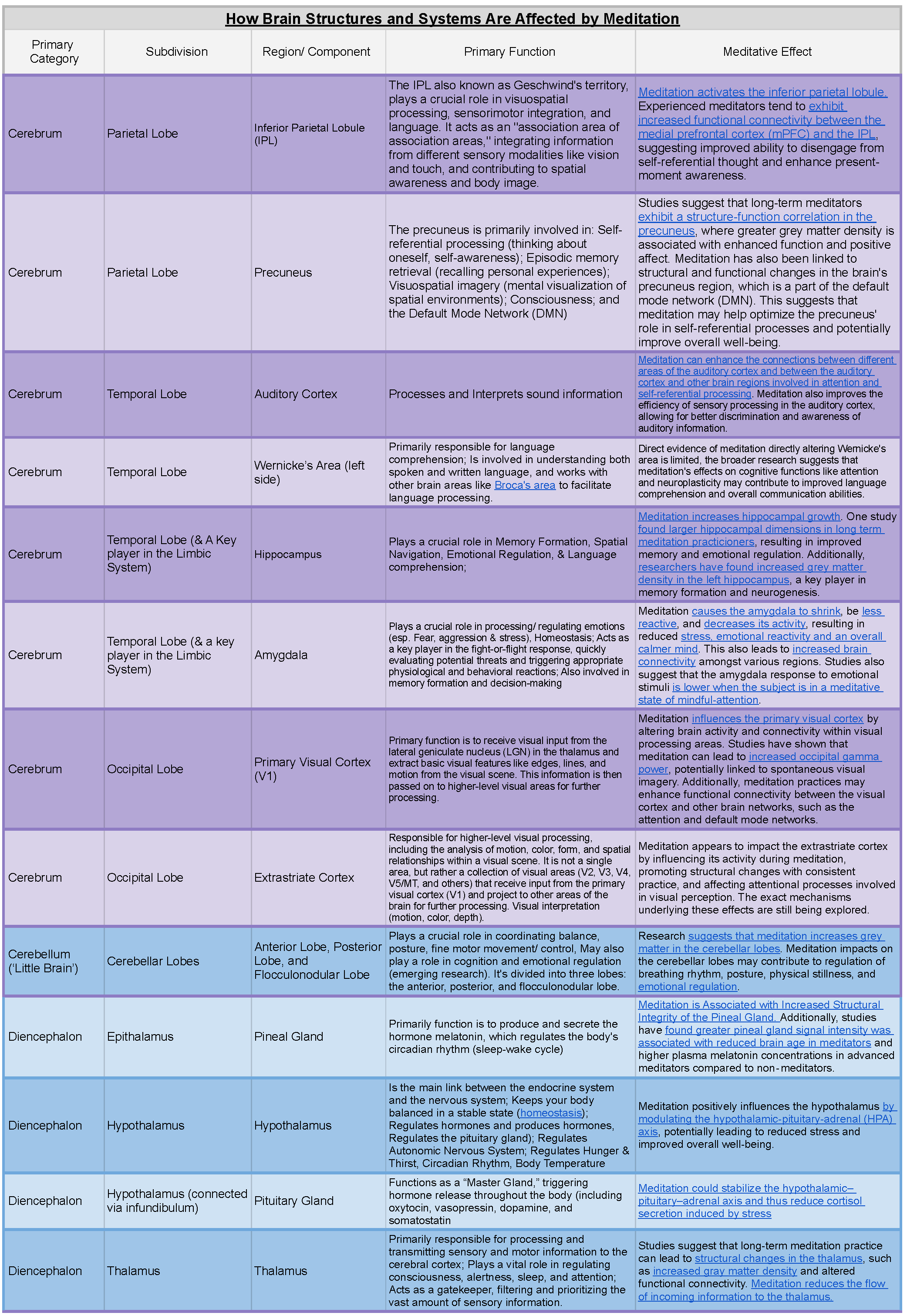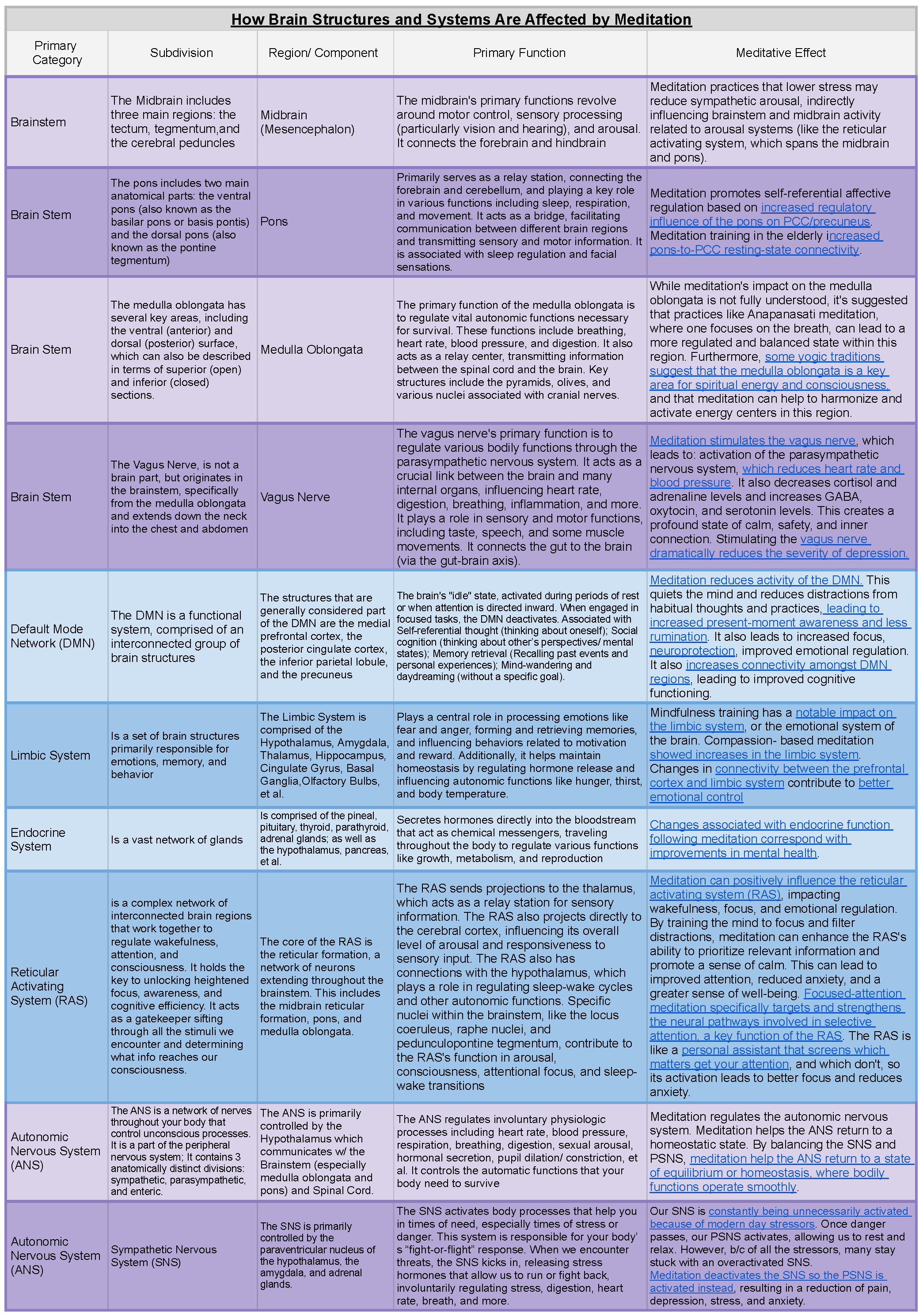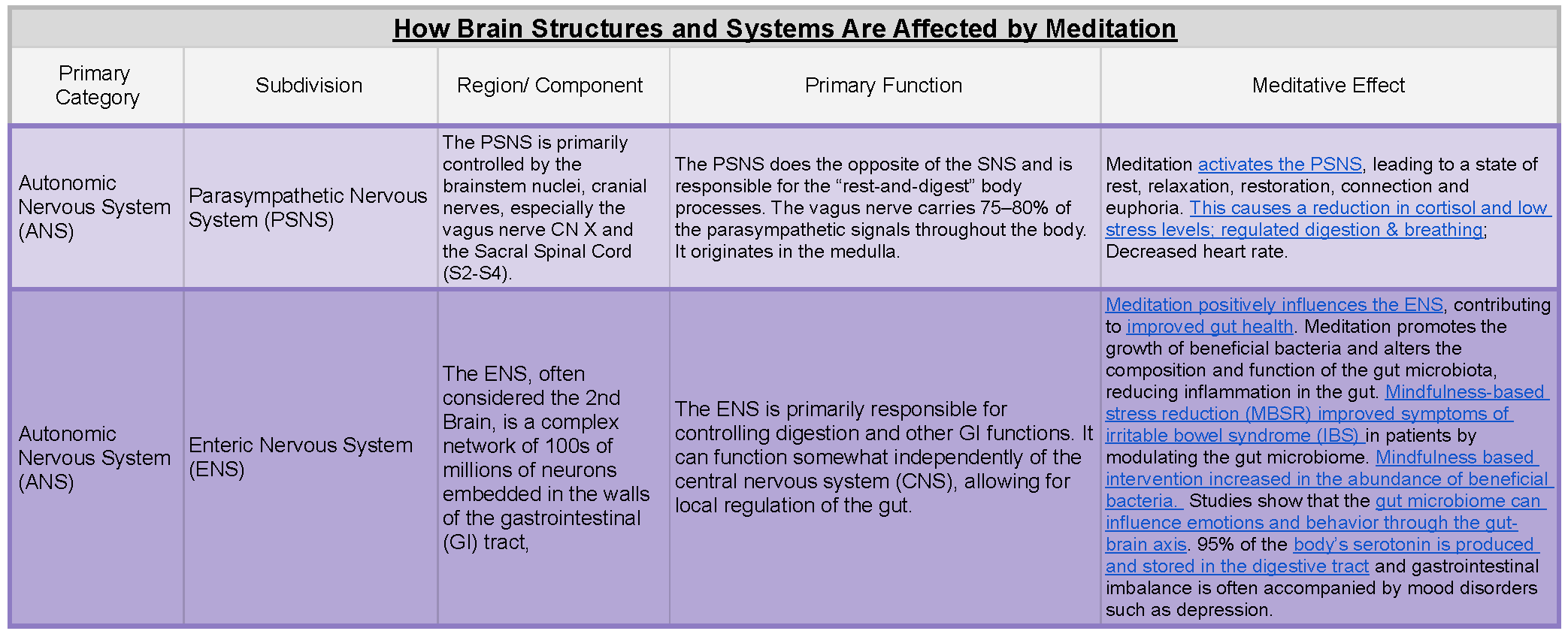The Science of Meditation: How Meditation Changes Your Brain and Being
The Peace You're Searching For Is Already Happening
We tend to think of meditation as something to achieve, as if it's a skill, a goal, or a final state of calm we ‘arrive at’ after doing enough ‘effort’. But what if meditation isn’t something you do? What if meditation is something that naturally happens when you stop doing?
In Patanjali's Yoga Sutras, the final three limbs of the eightfold path are outlined as dharana (concentration), dhyana (meditation), and samadhi (absorption/ contemplation). Each limb (or stage) builds on the other and is necessary to pass through to reach the next stage, ultimately leading to full meditative transcendence. The 7th (dhyana [meditation]) and 8th (samadhi [absorption]) steps are ‘non- doing’ involuntary responses that naturally evolve from their predecessors. While the 6th Step (dharana [concentration]) is a doing act, which can be learned and refined. Meditation (dhyana) and absorption/ contemplation (samadhi) are not skills that can be learned, as they are involuntary responses. They are natural states of being. Think of it like this: we learn how to eat, but we do not learn how to digest. Similarly, we learn how to concentrate, but we do not learn how to meditate.
Like everything else we do, meditation rewires our neural circuits. Our brain develops through neural connections. Neurons, the information processing cells in our brains, connect to make neural pathways, which are responsible for our thoughts, sensations, feelings, and actions. When we repeat activities, we strengthen these neural pathways. Meditation changes how these pathways function and are structured.
In this article, we will focus on the final three limbs, or Antaranga (the inner practices of the Eightfold Path, also known as Raja or Ashtanga Yoga); and, we will explore what happens neurophysiologically as one moves through each limb to reach the highest meditative state, what neurochemical processes underlie meditation, how meditation alters brainwave patterns, and what neuroanatomical changes occur during meditation.
The Neurophysiology of Dharana, Dhyana, and Samadhi: What Happens in the Brain During Samyama
Dharana: Focused Concentration
Dharana, or concentration, which can also be defined as ‘one-pointed focus’, involves consciously fixing the mind on a single point. In this stage, you're intentionally directing your attention to a single object, which can be anything. Practitioners often use things like breath, mantras, visualizations, or even candle flames. In this stage, we return our focus every time the mind drifts.
This stage demands active mental engagement and sustained voluntary attention, promoting a deep state of concentration. This process essentially filters out distractions, thus reducing cognitive load and allowing the brain to enter a more peaceful and unified state.
Neurophysiology of Dharana (Concentration)
Dharana strengthens the neural architecture needed for attention and self-regulation.
As you fix your attention on a single object (e.g. breath or mantra), you suppress wandering thoughts (vrittis) and engage the prefrontal cortex (critical for executive control, goal-directed attention, and working memory) and the anterior cingulate cortex (which monitors attention and detects conflict when the mind wanders).
As focused attention increases, the default mode network (associated with daydreaming and self-referential thinking) begins to quiet.
Neurons in the regions stated above fire coherently and sodium and potassium ion channels open rhythmically. Calcium influxes at axon terminals trigger more neurotransmitter release (like GABA and dopamine) to support motivation, sustained focus, and stabilization.
During this state, your brain waves shift from chaotic beta waves (busy, scattered thoughts) into alpha waves (calm, alert concentrated thoughts).
At this point, meditation hasn’t begun yet. You're only concentrating, but setting the stage for something deeper. Many of the guides online that get promoted as meditations are actually just concentrations, including some of my own. Transitioning from concentration to true meditation is a gradual process. While short sessions of 15–30 minutes can be beneficial, true meditative states typically begin to unfold after 45 minutes or more of sustained, unbroken focus. This time increases for novice practitioners and decreases for advanced practitioners.
Dhyana: Meditation
Over time, concentration transitions into a spontaneous, effortless flow state. This is dhyana, the unbroken, effortless flow of concentration. Unlike Dharana (concentration), which is short lived and requires effort to sustain attention, dhyana marks a shift into a more automatic, stabilized attentional state. You're no longer "trying" to focus because the mind has become quietly absorbed. Attention flows continuously toward the object, without breaks and without effort.
Meditation is a “non- doing act.” It is not something that can be forced nor controlled, but something our beings naturally fall into. It is an involuntary response to the voluntary act of concentration. In the same way that when we eat, our bodies involuntarily digests food; when we concentrate, our bodies involuntarily enter into states of meditation.
Neurophysiology of Dhyana (Meditation)
Dhyana allows for neural integration and the development of a stable attentional baseline with increased emotional and somatic awareness; Quieting deepens, leading to reduced mental chatter. With continued, unbroken concentration, the mind enters into a flow state of meditation.
The insula (a key hub for integrating emotional and bodily information) becomes more active, promoting a sense of internal awareness and reduced self-referential processing. Additionally, the fronto-insular network is strengthened through increased functional connectivity, which enhances interoception (inner body awareness).
The default mode network continues to deactivate, especially the posterior cingulate cortex and the precuneus (which overtime becomes flooded with more grey matter).
The anterior cingulate cortex (which is linked to emotional regulation and internal awareness) becomes engaged and activated.
Parts of the parietal lobe become deactivated, softening the sense of the individual self.
Levels of dopamine (the neurotransmitter of pleasure), serotonin (the neurotransmitter of happiness), and GABA (the neurotransmitter of calmness) all rise in response to meditation.
Extended alpha waves begin to dip into theta and gamma waves, resulting in synchrony across cortical networks (EEG coherence).
Samadhi: Absorption
The eighth (and final stage) of the transcendental meditative experience is samadhi, or pure absorption. There is no sense of "you" meditating anymore. You become one with the object meditated upon and there is no longer an object or awareness (just stillness). This is the state described in many spiritual traditions as union, oneness, transcendence, or nirvana.
Samadhi is the culmination of a meditative practice, characterized by full absorption in the object of meditation and the dissolution of the subject-object duality. In this state, the meditator experiences timelessness, egolessness, and non-conceptual awareness. As one progresses to this more profound state of samadhi, the fluctuations of the mind completely cease, leading to a sense of unity. Neurobiological theories suggest that this may be related to the dissolution of the ego, where the default self-referential processes decrease.
Neurophysiology of Samadhi (Absorption)
Samadhi transcends dualistic processing, dissolving habitual neural patterns and allowing transient states of global integration. In its early stages, it is accompanied by neurochemical surges linked to awe, bliss, and expanded consciousness.
The default mode network becomes completely silenced. There is no self-referential thought at all.
Parts of the parietal lobe continue to deactivate, particularly the right posterior superior parietal lobule, which integrates spatial orientation; its deactivation is linked to the dissolution of self/other boundaries.
Due to the deactivation of the sympathetic nervous system and the activation of the parasympathetic nervous system, heart rate and breathing decrease.
Surges of neurotransmitters like endorphins (which are associated with bliss and pain relief), serotonin (associated with states of tranquility and self-transcendence), and anandamide and oxytocin (associated with feelings of unity, compassion, and spiritual elevation) are all released.
Gamma and theta waves are sustained during early stages of samadhi. Once the highest form of samadhi (seedless absorption where non-duality exists) is reached, delta waves surface.
Brain regions begin firing highly synchronized activity across multiple networks, resulting in global EEG coherence; Long-range synchronization across the cingulate cortex, insula, and thalamus strengthen.
The general step-by-step process of what’s happening Neurophysiologically During Meditation:
When we meditate, we change our level of focus, often slowing things down by breathing deeply, relaxing the muscles, and directing attention away from the outside world. This change in focus sends a signal to the brain that it's time to shift gears.
This shift alters how our autonomic nervous system functions, activating the parasympathetic branch (“rest and digest”) and deactivating the sympathetic branch (“fight/flight/freeze/fawn”). The parasympathetic nervous system tells our bodies to slow down and conserve energy by regulating the heart rate, the breath rhythm, blood pressure, and more. Additionally, our calmer state of mind (which induces relaxed breathing and muscles) sends sensory feedback to the brain via the vagus nerve and other pathways. This input modifies the pattern of signals traveling through the central nervous system, which continues to tell the brain: “We’re safe. We can slow down.”
Brain regions involved in stress and vigilance quiet down. The amygdala, which helps govern fear and stress responses, reduces its neuronal firing rate. Simultaneously, areas involved in attention, self-awareness, and interoception, like the prefrontal cortex, anterior cingulate cortex, and insula, begin firing more coherently and rhythmically, becoming activated but in a more synchronized way. This leads to a rebalancing of neural activity across brain networks.
This affects which neurons get activated. The new firing patterns trigger the increase of neurotransmitters (ones associated with more calm, peace, well-being, and connection), like serotonin, GABA, and oxytocin, and suppress stress hormones like adrenaline and cortisol. These chemicals reinforce neurons to fire in calm, rhythmic circuits, creating feedback loops that keep brainwaves in a meditative state.
Neurons continue to fire in rhythmic patterns, creating slower neural oscillations. When neurons shift from scattered or high-frequency activity (like during stress or multitasking) to slower, more synchronized firing, the result is a shift in brainwave patterns. These patterns are more organized and less erratic, ultimately leading to EEG coherence. We move from beta waves (alert thinking), to alpha waves (calm focus), to theta waves (deep reflection), to gamma waves (peak focus & unity consciousness), to delta waves (unconscious healing and high receptivity to our subconscious). The lower-frequency waves reflect greater synchrony and less external distraction.
The whole-brain rhythm slows and harmonizes. As these changes spread through multiple brain networks, the brain becomes more globally synchronized. This means that distant regions of the brain begin firing in coherent waves, rather than each doing their own thing. This marks a full shift in your state of consciousness, one infused with peace, clarity, stillness, unity, and insight. We enter a new state of awareness.
The Chemistry of Calm: Neurotransmitters and Hormones Altered by Meditation
Meditation is often used in place of drug therapy because it shifts your brain’s chemistry. When we meditate, our neurons begin to fire in new patterns, altering our internal chemical landscape.
But what does that actually mean?
Your brain is made up of billions of neurons (nerve cells). A neuron has three main parts: dendrites, a soma (cell body), and axons. A dendrite is where a neuron receives input from other cells. The soma is where the nucleus lies, where the neuron’s DNA is housed, and where proteins are made to be transported throughout the axon and dendrites. The axons are like the cable transmissions of the neuron, where electrical impulses from the neuron travel to be received by other neurons. (Many neurons also have a myelin sheath, a protective covering that surrounds the axon). When a neuron wants to talk to another neuron, it sends an electrical message, called an action potential, throughout the entire axon.
These neurons don’t physically touch; instead, they communicate across tiny gaps called synapses. The way they “talk” is by releasing neurotransmitters, chemical messengers, that float across the gap and bind to receptors in the dendrites of a neighboring neuron to continue the message. The continuation of communication (or, firing) of neurons is what we call a neural pathway, or a series of connected neurons that transmit signals throughout the brain and body, allowing for communication between different regions and enabling various functions. Think of them like physical streets; when you continuously take the same routes; you form habits. Meditation increases neuroplasticity, or our brain’s ability to rewire itself by strengthening existing neural pathways, creating new ones, and allowing unused ones to weaken over time.
the step-by-step process of how neurons communicate
When a neuron is activated, by a stimulus like sound, light, emotion, or even internal thoughts, it generates an action potential.
It sends the action potential (an electrical impulse caused by the movement of ions like sodium and potassium) down its axon, like a signal down a wire.
When the impulse reaches the end of the axon (the presynaptic terminal), it triggers the release of neurotransmitters into the synapse from small sacs called vesicles into the synaptic cleft (the gap between neurons).
The neurotransmitters then float across the synaptic cleft (space between the neurons) and bind to receptors on a neighboring neuron’s dendrites.
If the message is strong enough, the next neuron fires and the signal continues. The binding of neurotransmitters to receptors can either excite (increase the likelihood of an action potential) or inhibit (decrease the likelihood of an action potential), meaning that neurotransmitters can be either excitatory (continue the action potential) or inhibitory (stop it).
After transmitting their message, neurotransmitters are either broken down by enzymes, reabsorbed by the presynaptic neuron (reuptake), or drift away from the synapse.
Synaptic activity (the process of neurotransmitters crossing the synaptic cleft to a neighboring neuron) generates a subtle electrical field, which is also called a postsynaptic potential (post = behind), or small voltage changes. Whenever the voltage change associated with a postsynaptic potential occurs for a larger group of neurons (about 1000 or more), the result is a much stronger electrical field. In other words, when thousands of neurons fire in sync, those PSPs add up, creating electrical rhythms we can measure as brainwaves (also called neural oscillations).
Brain waves (rhythmic fluctuations of electrical activity) are generated by the synchronized electrical firing of large numbers of neurons. This synchronized activity primarily reflects the synchronized PSPs (postsynaptic potentials). The electrical pulses (aka voltage changes aka PSPs) produced by synchronal neuronal firing determine which brain wave patterns are emitted.
In this way, neurotransmitters serve as the language of the brain. They’re what allow emotions, thoughts, actions, memories, and even consciousness to happen. Meditation changes the way that language is spoken, altering which neurons are activated, which determines which neurotransmitters are released and in what quantities.
Enter Hormones. While neurotransmitters operate quickly in the brain and nervous system, hormones are another class of chemical messengers that work more slowly and systemically. Instead of acting across synapses, hormones are released by tissue, organs, and glands (like the pituitary and pineal glands) into the bloodstream, where they travel throughout the body to influence mood, energy, digestion, immunity, and more.
So:
Neurotransmitters = lightning-fast messengers between neurons
Hormones = slower, long-range messages broadcast throughout the body
Meditation impacts both. It calms stress-related ones, while increasing ones that support joy, connection, and emotional balance.
How Meditation Impacts Neurotransmitters and Hormones
Meditation does not create neurotransmitters or hormones. Neurotransmitters are synthesized from amino acids, enzymes, and vitamins that come from the food we eat. Hormones are produced by tissues, organs, and glands, many of which belong to the endocrine system.
Meditation influences which classifications of neurons and hormones are activated (mainly those involved in emotional regulation, focus, pain modulation, and interoception [internal body awareness]) and which are suppressed (mainly those associated with stress and anxiety). Neurons are specialized to release certain types of neurotransmitters, depending on their type (but more specifically their function and location). Neurotransmitter releases modify the chemical landscape of our brain. Unfortunately, neurons in the brain are not always so easy to categorize. Researchers are still trying to devise a way to neatly classify the huge variety of neurons that exist in the brain. In the spinal cord, classification is a lot easier. Here, three main functional classes exist: sensory neurons, motor neurons, and interneurons. Although not always the most efficient option, observing which neurotransmitter a neuron releases can also be one way to classify neurons.
Meditation does not directly change the action potential (or, electrical pulse) of a neuron. Instead, it affects the overall neuronal firing pattern, activating some neuron types (and their associated neurotransmitters) while quieting others. Meditation acts as a stimulus that alters which network of neurons become activated, which in turn changes which neurotransmitters are released. Meditation changes which neurons communicate with each other, and those neurons release their specialized neurotransmitters. The action potential is a consistent electrical signal. It is the identity of the neuron that fires that determines which neurotransmitters are sent.
Again (for anyone new to neuroscience), meditation targets specific types of neurons. Since each neuron type releases its own set of specialized neurotransmitters, the shift in neuronal firing (or, communication) pattern changes the overall balance of neurochemicals released. The electrical signals (action potentials) themselves are universal, so it is the identity of the fired neuron that determines which chemical messenger is released. In other words, meditation alters brain activity by changing the frequency and synchronization of the way neurons communicate with each other and which neurons do the talking. These changes influence which neurotransmitters are released and in what quantities, which ultimately impact brainwave patterns and mental states.
For example, when the body experiences stress, like during physically strenuous activities like running, endorphins (a neurotransmitter that serves as our bodies’ natural pain reliever) are released to mitigate pain and support endurance. Similarly, when we meditate, stress may arise as we try to maintain one-pointed focus. But when we persist, by regulating the breath and remaining still and calm; the nervous system responds by releasing endorphins (and other calming neurotransmitters like GABA and serotonin), contributing to the sense of inner peace and euphoria that meditators often report. Because of this, the experience during meditation can be similar to that of a runner’s high.
Another example involves the production of the hormone melatonin which is released by the pineal gland when the sun goes down to regulate our circadian rhythms and prime our bodies for sleep. Meditative practices, especially those focused on the Third Eye (Ajna) Chakra or deeply calming practices like Yoga Nidra, also stimulate melatonin production. Meditation activates the parasympathetic nervous system, signaling the hypothalamus to shift the body’s internal chemistry toward balance and rest. This cascades through the pituitary and pineal glands, lowering stress hormones like cortisol, and boosting bonding and resting hormones like oxytocin and melatonin.
So while meditation does not generate neurochemicals or hormones from scratch; it modulates how and when they are released by altering the firing patterns of neurons, determining which neurotransmitters are activated or suppressed, and shifting the nervous system and endocrine activity to support calm, clarity, and internal harmony. It also rewires the brain’s hormonal command center to support deep rest, emotional regulation, and holistic healing.
Key Neurotransmitters and Hormones Impacted by Meditation
Adrenaline is released to prepare for stressful or dangerous situations. Adrenaline rush is the name for the quick release of adrenaline into our bloodstreams. Too much adrenaline can cause high blood pressure from pheochromocytoma. Meditation lowers baseline adrenaline levels by calming the sympathetic nervous system.
Anandamide is an endocannabinoid that activates the same receptors in the brain as THC, the psychoactive component of marijuana. This "bliss molecule" plays a significant role in promoting feelings of happiness and motivation. Research suggests that meditation practices can increase its production in the brain. When the ananda chakras awaken, they ignite anandamide.
Cortisol plays a crucial role in regulating various bodily functions, including blood sugar levels, metabolism, inflammation, and the body's response to stress. Too much or too little cortisol can result in negative effects like high blood sugar or fatigue. Regular meditation is proven to regulate cortisol levels, reducing chronic stress and inflammation.
Dopamine plays a key role in the brain's reward system, motivation, and movement. It's often called the "feel-good" chemical because it's released during pleasurable activities. Beyond pleasure, dopamine is also involved in mood, learning, memory, and even motor control. Meditation elevates dopamine levels.
Endorphins are released when the body feels pain or stress; they operate as natural pain relievers, which boost moods and incite feelings of euphoria. They’re also released during ‘pleasurable’ activities such as exercise, massage, eating, and sex. There are more than 20 different types of endorphins. Endorphins boost the release of dopamine in your body. People with a lack of endorphins may show signs of depression. Endorphins spike during extended or blissful meditative states. During these states, meditators often report euphoric feelings, similar to a runner’s high.
GABA (Gamma-Aminobutyric Acid) is the brain’s primary inhibitory neurotransmitter. It lessens the ability of a nerve cell to receive, create, or send chemical messages to other nerve cells. It reduces anxiety, hyperactivity, and calms the nervous system. GABA levels are very high in regular meditators. Many anti-anxiety medications work by increasing GABA; meditation does it naturally.
Melatonin is produced by the pineal gland in your brain and helps regulate sleep and circadian rhythms. It is increased in restful practices, like Yoga Nidra, and meditations that activate the 3rd Eye (Ajna) chakra. The result is better sleep, deeper rest, and pineal gland activation (which is linked to transcendental spiritual states).
Norepinephrine, also known as noradrenaline, is both a neurotransmitter and a hormone. It plays an important role in your body’s “fight-or-flight” response and is related to anxiety. Meditation leads to a reduction in norepinephrine, especially during stressful states. In one study, a group of heart failure patients practicing meditation displayed lower levels of norepinephrine in their blood samples compared to the controls who did not practice.
Oxytocin, also known as the “love hormone”, is associated with connection, trust, and bonding. Research suggests that oxytocin can have a positive impact on social behaviors. Two main physical functions of oxytocin are (1) to stimulate uterine contractions in labor and childbirth and (2) to stimulate contractions of breast tissue to aid in lactation after childbirth. Low oxytocin levels have been linked to symptoms of depression, including postpartum depression. It is activated in loving-kindness and compassion based meditations.
Serotonin regulates mood, sleep, and emotional stability and is often linked with deep peace, feelings of contentment and “oneness.” Many antidepressants target serotonin receptors to improve your mood and lessen depressive symptoms. Meditation activates the same pathways without a prescription.
Imbalances in neurotransmitters and hormones are present in many conditions, like major depressive disorder (MDD) and generalized anxiety disorder (GAD). Some medications target these receptors to allow your body to receive more or less of certain chemicals, while some drugs act similar to these chemicals to invoke similar responses in your body.
It’s pretty remarkable isn’t it? That just focusing on your breath or gazing at the moon can create the same effect as medications or illegal drugs. Meditation literally refines and reorganizes the electrochemical language of the brain.
Altered Neural Oscillations: How Meditation Changes Brainwave Activity and Patterns
Brainwaves, or neural oscillations, are patterns of electrical activity produced by the synchronized communication of neurons that reflect different states of consciousness and cognitive activity. They are created when groups of neurons fire together in specified ways to send signals to other groups of neurons. Synchronized neuronal communication produces electrical patterns. Brainwaves change depending on what you’re doing, thinking, or feeling. The rhythm and frequency of these waves reflect your state of consciousness.
Brain waves are produced by synchronized groups of neurons firing (or, communicating) with each other in a rhythmic pattern. Neurons send messages electrochemically, meaning they use both electrical pulses (action potentials) and chemical signals (neurotransmitters) to communicate. Neurotransmitters cause electrical signals, as these chemicals are electrically-charged. Neurons propagate an electrochemical signal by shipping electrolytes, like sodium and potassium, inside and outside of their membranes in what's known as an action potential. An action potential is a rapid, short-lasting electrical signal that fires (travels) down the axon of a neuron until it reaches a communication point with another neuron. At this point, neurotransmitters (chemical messengers) are released at the end of the axon (the axon terminal) from small containers called vesicles. These neurotransmitters cross a gap called the synapse and bind to receptors on the next neuron, delivering the message.
When neurotransmitters bind to receptors on a neighboring neuron, they cause small changes in the electrical state of that neuron, called postsynaptic potentials (PSPs). These changes can either encourage the neuron to fire (excitatory) or prevent it from firing (inhibitory). However, not every PSP leads to the neuron sending its own signal; only when enough excitatory signals add up to cross a certain threshold does the neuron generate an action potential. Rather than a simple chain reaction, neurons communicate within complex networks, with signals moving forward and backward and various forms of inhibition shaping the overall activity. Brainwaves, then, are the result of many neurons firing together in coordinated rhythms, reflecting the combined timing and strength of these postsynaptic potentials across the network.
This process repeats again and again, forming what’s known as a neural pathway. When many neurons fire in sync, they generate rhythmic electrical patterns (brain waves), measurable using tools like EEG (electroencephalogram, which means writing the electrical activity of the brain).
These brainwave patterns (or neural oscillations) can happen over the period of milliseconds, weeks, or even months. The neural oscillations are measured by their frequency and amplitude. Frequency is measured in Hertz (Hz), or how many times a wave repeats itself per second. One hertz equates to one wave cycle per second. The frequency of the brain waves indicates the level of neural activity and is linked to specific cognitive states. Amplitude tells you the magnitude or intensity of the brain wave pattern.
In simpler terms, neurons “talk” to each other by firing little sparks down their axons. When it’s time to send a message, these sparks release neurotransmitters (chemical messengers). The neurotransmitters jump across a gap (the synapse) to deliver messages to the next neuron. When a large number of neurons talk in sync, it creates brain waves (electrical rhythms). Think of it like this: If everyone (neurons) is talking individually and randomly, you hear a lot of noise; but if groups of people start clapping or chanting in unison (like neurons firing together), you'll hear a distinct rhythmic beat (brainwave pattern).
You can also think of it like a row of dominoes falling or a game of telephone: each neurotransmitter release prompts the next neuron to respond, which prompts the next, and so on. Instead of words, the message is electrical activity rippling through the brain. As more neurons fire in rhythm, these small signals build into larger, measurable brainwave patterns, like many voices chanting in unison.
How Brain Waves Really Work: Why Your Brain Isn’t Just in One “State”
You’ve probably heard that different brainwaves are associated with different states of consciousness, like alpha for relaxation or gamma for focus, but that’s an oversimplification.
In reality, your brain doesn’t operate on just one wave at a time. The brain contains over 85 billion neurons, organized into specialized regions that each handle different functions, from sensory input and motor control to memory, emotion, and self-awareness. These neurons fire in patterns that create electrical rhythms, or brainwaves, and these rhythms can vary not only between regions but even between layers within a single region.
Research shows that faster waves tend to show up in the outer layers of the brain, while slower waves are found deeper inside. So even within one brain area, multiple rhythms may be active at once.
What brainwave is "dominant" depends on many variables, including which part of the brain you're observing, how you're measuring it (e.g., EEG electrodes on the scalp vs. deeper imaging), and what time scale you're analyzing (milliseconds vs. minutes). And just as important: What is the person doing? Are they sitting still with their eyes closed? Are they exercising? Daydreaming? In deep meditation? Your mental, emotional, and physical state will change the brain’s electrical rhythm across different regions, sometimes in just a fraction of a second.
So rather than imagining a brain that shifts neatly from "beta to alpha to theta," it’s more accurate to say your brain is a dynamic orchestra, with multiple wave patterns playing simultaneously, shifting and blending in response to what you feel, think, perceive, and do.
How Meditation Transforms Your Brainwaves
Meditation doesn’t create brainwaves, it changes the conditions under which specific brainwave patterns emerge. Different thoughts, emotions, and physical states cause neurons to fire in distinct rhythms. Meditation changes the activity and firing patterns of neurons (how fast, slow, in sync, erratic, etc. they fire), encouraging certain networks to activate (usually ones linked to calm, attention, and emotional regulation) and others to quiet down (usually ones tied to stress or distraction).
Meditation systematically alters neural activity by shifting your attention, breath, and sensory input. As you settle into stillness, your autonomic nervous system transitions from sympathetic dominance ("fight or flight") to parasympathetic dominance ("rest and digest"). This switch quiets activity in stress-related brain regions like the amygdala, and enhances regulation in introspection centers like the prefrontal cortex, insula, and anterior cingulate cortex. As a result, the firing patterns of neurons change, becoming more rhythmic and synchronized, and less erratic. This changed activity culminates in the alteration of brainwave patterns emitted.
Additionally, meditation changes the chemical environment of the brain, as more calming neurotransmitters are released and neurotransmitters associated with stress are suppressed (e.g., decreased cortisol, increased serotonin, GABA, oxytocin). Neurotransmitters don’t just influence your mood; they actively help modulate and reinforce brainwave patterns. Through the balance of excitatory and inhibitory neurotransmission, they regulate which neurons fire and which remain silent. Neurotransmitters and receptors work together within localised dendritic networks to achieve this selective gating, which determines the structure and stability of oscillatory activity, allowing certain electrical rhythms to emerge while suppressing others. The balance of excitatory and inhibitory neurotransmission at these neurons plays a key role in creating and maintaining brainwave patterns.
Meditation changes how neurons communicate, which produces new patterns of brainwave activity aligned with calm, clarity, and deep awareness. When enough neurons fire in a synchronized rhythm, they generate electrical activity or coherent brainwave patterns like alpha (related to relaxed alertness), theta (related to deep emotional calm), gamma (related to heightened awareness), or delta (related to unconscious healing).
Brain Wave Shifts During Meditation
Electrical activity emanating from the brain is displayed in the form of brainwave patterns. Studies using EEG and fMRI have consistently shown measurable shifts in brain wave activity during meditative processes. The brain moves through a symphony of electrical patterns during meditation. Dharana (concentration) suppresses beta waves (active thinking) and increases alpha waves (relaxed alertness). The sustained flow of concentration into dhyana (meditation) activates deeper networks, pushing rhythms into theta (deeper focus). Samadhi (absorption) coordinates wide neural networks, producing gamma synchrony (associated with heightened awareness, unity, and insight) and delta waves (unconscious healing). It is important to note that brainwave patterns aren’t fixed and can vary based on the meditation technique, individual differences, and level of experience.
To download or expand this table, click on the image above. The downloadable table also includes hyperlinks to sourced info.
To better understand how brainwave patterns shift naturally, let’s consider a familiar example: the transition from wakefulness to sleep and back again. As we prepare to sleep, such as reading quietly in bed, our brain typically operates in the low beta range. Once we turn off the lights and close our eyes, brainwave activity gradually slows, transitioning sequentially from beta to alpha, then to theta and gamma, before finally reaching the deep restorative state of delta during sleep. Conversely, when awakening from deep sleep, brainwave frequencies rise through these stages in reverse, moving from delta to gamma, then theta, followed by alpha, and ultimately returning to beta as we become fully alert. This natural ebb and flow of brainwave patterns illustrates the dynamic nature of our neural activity, providing valuable insight into how meditation can intentionally guide and influence these brain states.
Delta Waves and The Hypothesis of Deep Samadhi
While delta waves are typically associated with deep, dreamless sleep, some contemplative traditions and personal accounts suggest a potential link between delta activity and the deeper stages of meditation, specifically samadhi. Samadhi, as outlined in Patanjali’s Yoga Sutras, represents the culmination of meditative practice where individual ego dissolves, and the practitioner merges entirely with the object of meditation or pure awareness itself. In the highest form of Samadhi (Asamprajnata Samadhi [without cognition] also known as Nirbija Samadhi [seedless]), there is no duality, no self-reflection, no conscious thought. True Samadhi is not simply deep concentration; it is a state where even the awareness of meditating disappears. There is no "you" meditating, only pure, undifferentiated unity. The ego completely dissolves.
At present, empirical EEG research on Samadhi is extremely limited. No conclusive studies are available that definitively map brainwave patterns during Samadhi, especially in its highest forms. Samadhi is often associated with gamma, theta, and alpha brainwave patterns. However, based on both personal experience and analysis of existing brainwave literature, I propose that the deepest levels of Samadhi correlate with delta wave activity rather than gamma, theta, and alpha.
Delta waves (typically 0.5–4 Hz) reflect states of minimal conscious awareness. During deep Samadhi, practitioners often report complete loss of time, space, and self-identity, similar to the unconsciousness experienced in deep sleep. In my own experiences, there is a moment of white light and a sudden blankness, followed by a gentle return to awareness. These experiences do not match the heightened, conscious alertness typically associated with gamma, alpha, and theta waves. Rather, the samadhi experience aligns more closely with the stillness and egolessness characteristic of delta activity.
Biofeedback As a Tool for Healing
Brainwave patterns have also been used in pathology to show the existence of malfunctions in the brain, such as tumors and general mental disorders, like depression. This occurs when brain wave patterns become dysregulated, and one type of brainwave dominates too frequently or at the wrong time. You can fix brainwave dysregulation and train your brain to reach its optimal state through meditation and biofeedback.
Biofeedback is a learning methodology that allows users to acquire self-regulation skills to improve physical and mental health. The main purpose is to achieve voluntary control over involuntary physiological processes within the Central Nervous System (CNS) and Peripheral Nervous System. And yes, all body processes can be controlled, even the automatic ones.
While you don't need biofeedback to change your mental state, it can be helpful, especially for those who lack strong proprioception, as it allows the practitioner to determine progress during various processes. Biofeedback can help you know your particular brainwave activity during your meditation practice so you can take active steps to change the pattern to the desired state.
In conclusion, brainwaves are not states of mind, but a manifestation which allows one to know one’s state of mind. Meditation shifts your mental state toward calm, sensory withdrawal, and ultimately the complete dissolution of the ego. These wave shifts reflect the transition from doing to being to transcendence, from control to total surrender.
Neuroanatomy of Meditation: How Brain Structures and Systems Are Affected by Meditation
Weighing about 3 pounds in the average adult, the brain is approximately 60% fat, with the remaining 40% made up of water, protein, carbohydrates, and salts. The brain is not a muscle, but an intricate network of blood vessels and nerves, including neurons and glial cells. These components form highly organized structures and systems that govern everything from basic survival functions to higher-order cognition. By understanding the brain’s anatomy, we can better appreciate how meditation doesn’t just influence mental states, it actively shapes neural structures and functions. In this section, we will explore how specific brain regions and networks are shaped and influenced by meditative practice.
Table 1 of 4. To expand or download the full version of this table, click on the image above. The downloadable table also includes hyperlinks to sourced info.
Table 2 of 4. To expand or download the full version of this table, click on the image above. The downloadable table also includes hyperlinks to sourced info.
Table 3 of 4. To expand or download the full version of this table, click on the image above. The downloadable table also includes hyperlinks to sourced info.
Table 4 of 4. To expand or download the full version of this table, click on the image above. The downloadable table also includes hyperlinks to sourced info.
A Partial Outline of The Nervous System
├── Central Nervous System (CNS) → Brain + Spinal Cord
├── Peripheral Nervous System (PNS)
├── Somatic Nervous System (voluntary)
├── Autonomic Nervous System (involuntary)
└── Sympathetic Nervous System (fight/ flight/ freeze/ fawn)
└── Parasympathetic Nervous System (rest and digest)
└── Enteric Nervous System (gut brain)
This outline is included because meditation exerts profound effects on multiple branches of the nervous system, particularly the autonomic nervous system. Understanding how these systems interconnect provides essential context for interpreting the specific brain regions and physiological processes influenced by meditative practices.
To appreciate these effects fully, it helps to briefly review the basic organization of the nervous system. The nervous system is the body’s complex communication network, divided into two main branches: the central nervous system (CNS) and the peripheral nervous system (PNS). The CNS consists of the brain and spinal cord, serving as the primary control center for processing information and coordinating bodily functions. The PNS connects the CNS to the rest of the body and is further divided into two parts. The somatic nervous system controls voluntary movements, such as moving your arms or walking. The autonomic nervous system regulates involuntary functions like heart rate, digestion, and breathing. Within the autonomic system, there are three subdivisions: the sympathetic nervous system, which activates the body’s “fight/ flight/ freeze/ fawn” response in stressful situations; the parasympathetic nervous system, which calms the body down and promotes “rest and digest” functions; and the enteric nervous system, sometimes called the “gut brain,” which manages digestion independently of the brain and spinal cord.
Meditation Is a Non-Doing Act
Meditation isn’t something you achieve. It’s something you allow. Concentration (Dharana) may take effort, but true meditation (Dhyana) and absorption (Samadhi) are spontaneous and involuntary reactions. They arise when interference ends.
Your brain knows how to meditate. Your body remembers how to be still. Your consciousness knows how to return home.
You don’t need to seek silence. You just need to stop interrupting it.
The neurological processes underpinning meditation involve a complex interplay of brain activity, neurotransmitter fluctuations, and changes within the autonomic nervous system. The resulting states of euphoria and profound connection reflect both measurable neurophysiological changes and subjective experiences that can enrich one’s understanding of consciousness and existence. As you continue to deepen your meditation practice, consider these neurophysiological insights as complementary to the philosophical teachings on this life-changing practice.
References:
Amitray.com. (n.d.). Various articles on neuroscience of meditation. https://amitray.com
Baer, R. A. (2003). Mindfulness training as a clinical intervention: A conceptual and empirical review. Clinical Psychology: Science and Practice, 10(2), 125–143. https://pubmed.ncbi.nlm.nih.gov/16624497/
Baijal, S., et al. (2010). Occipital gamma activation during Vipassana meditation. International Journal of Psychophysiology, 75(3), 258–265. https://pmc.ncbi.nlm.nih.gov/articles/PMC2812711/
Balconi, M., & Fronda, G. (2023). The neural correlates of long-term meditation: Evidence from fMRI studies. Brain Sciences, 13(12), 1677. https://www.mdpi.com/2076-3425/13/12/1677
Bansal Neuro. (n.d.). How meditation transforms your brain: A neuroscientific perspective. Bansal Neuro Blog. https://www.bansalneuro.com/how-meditation-transforms-your-brain-a-neuroscientific-perspective.html
Berkovich-Ohana, A., & Glicksohn, J. (2014). Meditation, default mode network, and self-referential processes. Frontiers in Human Neuroscience, 8, 452. https://pmc.ncbi.nlm.nih.gov/articles/PMC4529365/
Berkovich-Ohana, A., Glicksohn, J., & Goldstein, A. (2016). Mindfulness-induced changes in gamma band activity – Implications for the default mode network, self-reference, and attention. Brain Research, 1719, 48–59. https://www.sciencedirect.com/science/article/abs/pii/S0278262615300439
Bergland, C. (2015, November 25). Your precuneus may be the root of happiness and satisfaction. Psychology Today. https://www.psychologytoday.com/us/blog/the-athletes-way/201511/your-precuneus-may-be-the-root-happiness-and-satisfaction
Bergland, C. (2016, February 25). Mindfulness meditation and the vagus nerve share many powers. Psychology Today. https://www.psychologytoday.com/us/blog/the-athletes-way/201602/mindfulness-meditation-and-the-vagus-nerve-share-many-powers
Boston University. (2014, February 8). The power of meditation. BU Office of Mindfulness Blog. https://sites.bu.edu/ombs/2014/02/08/the-power-of-meditation/#:~:text=The%20thalamus%20helps%20focus%20your,it%20is%20ready%20to%20respond.
Brain, M. (2019, November 8). Zen gamma. Scientific American. https://www.scientificamerican.com/article/zen-gamma/
Brewer, J. A., Worhunsky, P. D., Gray, J. R., Tang, Y.-Y., Weber, J., & Kober, H. (2011). Meditation experience is associated with increased cortical thickness. NeuroReport, 22(3), 115–119.
Calm. (2020, October 14). How meditation changes your brain [Video]. YouTube. https://www.youtube.com/watch?v=ca0uLyRTrQ0
Calm. (n.d.). The neuroscience of meditation. Calm Blog. https://www.calm.com/blog/the-neuroscience-of-meditation
Cedars-Sinai. (n.d.). Stimulating the vagus nerve. Cedars-Sinai Blog. https://www.cedars-sinai.org/blog/stimulating-the-vagus-nerve.html
Chudler, E. H. (n.d.). Action potentials. University of Washington. https://faculty.washington.edu/chudler/ap.html#:~:text=An%20action%20potential%20occurs%20when,created%20by%20a%20depolarizing%20current.
Clarke BioScience. (n.d.). Meditation and gamma brain waves [Video]. YouTube. https://www.youtube.com/watch?v=e617_5c5JGg
Coghlan, A. (2017, September 28). Different meditation types train distinct parts of your brain. New Scientist. https://www.newscientist.com/article/2149489-different-meditation-types-train-distinct-parts-of-your-brain/
Coghlan, A. (2017, October 18). Different meditation types train distinct parts of your brain. New Scientist. https://www.newscientist.com/article/10.3389/fnhum.2012.00292/full
Cleveland Clinic. (n.d.). Vagus nerve stimulation. Cleveland Clinic Health Essentials. https://health.clevelandclinic.org/vagus-nerve-stimulation
Davidson, R. J., & McEwen, B. S. (2012). Social influences on neuroplasticity: Stress and interventions to promote well-being. Nature Neuroscience, 15(5), 689–695. https://pmc.ncbi.nlm.nih.gov/articles/PMC3072791/
Dorsher, P. T., & McIntosh, P. M. (2016). Meditation-induced neuroplasticity and clinical applications. Neuropsychiatric Disease and Treatment, 12, 2369–2381. https://pmc.ncbi.nlm.nih.gov/articles/PMC4769029/
Dreamclinic. (n.d.). Anatomy: The enteric nervous system. Dreamclinic. https://dreamclinic.com/anatomy-the-enteric-nervous-system/
Eastside Writers. (n.d.). The gateway to super consciousness: The profound spiritual significance of the medulla oblongata. Medium. https://eastsidewriters.medium.com/the-gateway-to-super-consciousness-the-profound-spiritual-significance-of-the-medulla-oblongata-2d7321fa94cd
Engstrom, M., & Soderstrom, H. (2012). Meditation-related effects on the human thalamus: A human neuroimaging study. Frontiers in Human Neuroscience, 6, Article 346. https://www.frontiersin.org/journals/human-neuroscience/articles/10.3389/fnhum.2012.00346/full
Elsevier. (n.d.). Anandamide. ScienceDirect Topics: Neuroscience. https://www.sciencedirect.com/topics/neuroscience/anandamide
Ezra. (n.d.). Meditation benefits for the brain. Ezra Blog. https://ezra.com/blog/meditation-benefits-for-brain
Farrow, T. F. D., et al. (2024). Neural mechanisms of meditation effects: A review and meta-analysis. Neuroscience Insights, 19, 10942509. https://pmc.ncbi.nlm.nih.gov/articles/PMC10942509/
Gard, T., Holzel, B. K., Sack, A. T., Hempel, H., Lazar, S. W., Vaitl, D., & Ott, U. (2012). Pain attenuation through mindfulness is associated with decreased cognitive control and increased sensory processing in the brain. Cerebral Cortex, 22(11), 2555–2563. https://pmc.ncbi.nlm.nih.gov/articles/PMC3090218/
Gardner, A. (2013, January 28). Meditators under the microscope. Mindful. https://www.mindful.org/meditators-under-the-microscope/
Goleman, D., & Davidson, R. J. (2017). Altered traits: Science reveals how meditation changes your mind, brain, and body.
Goyal, M., Singh, S., Sibinga, E. M. S., Gould, N. F., Rowland-Seymour, A., Sharma, R., ... & Haythornthwaite, J. A. (2014). Meditation programs for psychological stress and well-being: A systematic review and meta-analysis. JAMA Internal Medicine, 174(3), 357–368. https://www.ncbi.nlm.nih.gov/pmc/articles/PMC4895748/
Great Minds Clinic. (2022, March 3). What are neural pathways? https://www.greatmindsclinic.co.uk/blog/what-are-neural-pathways/
Haase, L., Thom, N. J., Shukla, A., Davenport, P. W., & Simmons, A. N. (2016). Meditation changes alpha band power: A controlled EEG study. International Journal of Psychophysiology, 111, 87–95. https://pmc.ncbi.nlm.nih.gov/articles/PMC3570934/
Happier. (n.d.). The science of meditation: What we know and why it matters. HappierApp Blog. https://www.happierapp.com/meditationblog/science-of-meditation
Harvard Health Publishing. (n.d.). Understanding the stress response. Harvard Health. https://www.health.harvard.edu/staying-healthy/understanding-the-stress-response
Holzel, B. K., Lazar, S. W., Gard, T., Schuman-Olivier, Z., Vago, D. R., & Ott, U. (2011). How does mindfulness meditation work? Proposing mechanisms of action from a conceptual and neural perspective. Perspectives on Psychological Science, 6(6), 537–559. https://www.pnas.org/doi/10.1073/pnas.1011043107
Ignite Yoga Dayton. (n.d.). 5 brain wave stages for power meditation. Ignite Yoga Dayton Blog. https://igniteyogadayton.com/5-brain-wave-stages-for-power-meditation/
Inchausti, F., & Ortiz-Terán, L. (2023). The effects of mindfulness meditation on the brain: A meta-analytic review. bioRxiv. https://www.biorxiv.org/content/10.1101/2023.10.27.564494v1.full
Ingalhalikar, M., Smith, A., Parker, D., Satterthwaite, T. D., Elliott, M. A., Ruparel, K., Hakonarson, H., Gur, R. E., Gur, R. C., & Verma, R. (2014). Sex differences in the structural connectome of the human brain. Proceedings of the National Academy of Sciences, 111(2), 823–828. https://pmc.ncbi.nlm.nih.gov/articles/PMC4351565/
Institute of Human Anatomy. (n.d.). Brainwaves - The science of meditation [Video]. YouTube. https://www.youtube.com/watch?v=wEulsc5L3Tk&t=16s
Jang, J. H., et al. (2016). Meditation training in the pons and posterior cingulate cortex. NeuroImage, 142, 186–197. https://www.sciencedirect.com/science/article/pii/S2352396416302742
Johns Hopkins Medicine. (n.d.). Anatomy of the brain. https://www.hopkinsmedicine.org/health/conditions-and-diseases/anatomy-of-the-brain
JuVIA. (n.d.). The impact of meditation on gut health: Unraveling the connection through the gut-brain axis. JuVIA Journal. https://juvia.me/blogs/journal/the-impact-of-meditation-on-gut-health-unraveling-the-connection-through-the-gut-brain-axis
Kang, D. H., Jo, H. J., Jung, W. H., Kim, S. H., Jung, Y. H., Choi, C. H., Lee, U. S., An, S. C., & Kwon, J. S. (2015). The effect of meditation on brain structure: Short- and long-term effects. Biological Psychiatry, 78(7), 440–447. https://pubmed.ncbi.nlm.nih.gov/32991525/
Kim, Y. W., Lee, S. H., Choi, T. K., Suh, S., Kim, B., & Lee, H. J. (2018). Effect of mindfulness-based cognitive therapy on amygdala resting-state functional connectivity in patients with generalized anxiety disorder. NeuroImage: Clinical, 19, 137–145. https://pmc.ncbi.nlm.nih.gov/articles/PMC6302143/
Kripalu Center for Yoga & Health. (n.d.). Your brain on mindfulness meditation. Kripalu. https://kripalu.org/resources/your-brain-mindfulness-meditation
Kripalu Center for Yoga & Health. (n.d.). Your brain on mindfulness meditation. Kripalu. https://medicine.utah.edu/students/wellness/what-is-wellness/mindful-meditation/how-does-it-work
Kral, T. R. A., et al. (2021). Mindfulness-based stress reduction-related changes in posterior cingulate resting brain connectivity. Scientific Reports, 11, 90729. https://www.nature.com/articles/s41598-021-90729-y
Kwak, S., & Han, D. H. (2016). Effects of meditation on brain structure and function: A review. Frontiers in Psychology, 7, 1698. https://www.frontiersin.org/journals/psychology/articles/10.3389/fpsyg.2016.01698/full
Lazar, S. W., Kerr, C. E., Wasserman, R. H., Gray, J. R., Greve, D. N., Treadway, M. T., McGarvey, M., Quinn, B. T., Dusek, J. A., Benson, H., Rauch, S. L., Moore, C. I., & Fischl, B. (2005). Meditation experience is associated with increased cortical thickness. NeuroReport, 16(17), 1893–1897. https://pmc.ncbi.nlm.nih.gov/articles/PMC3004979/
Luders, E., Clark, K., Narr, K. L., & Toga, A. W. (2011). Enhanced brain connectivity in long-term meditation practitioners. NeuroImage, 57(4), 1308–1316. https://pmc.ncbi.nlm.nih.gov/articles/PMC3345952/
Luders, E., Toga, A. W., Lepore, N., & Gaser, C. (2011). The underlying anatomical correlates of long-term meditation: Larger hippocampal and frontal volumes of gray matter. NeuroImage, 57(4), 1308–1316. https://pmc.ncbi.nlm.nih.gov/articles/PMC3184843/
Luders, E., et al. (2021). Thalamic structure and function in long-term meditation practitioners. Translational Psychiatry, 11, Article 16. https://www.nature.com/articles/s41398-021-01637-8#:~:text=The%20thalamus%20is%20one%20of%20the%20key,attention%2C%20and%20emotional%20response%20to%20sensory%20experiences.&text=In%20a%20study%20by%20Eileen%20Luders%2C%20there,in%20long%2Dterm%20meditation%20compared%20to%20control%20subjects.
Lutz, A., Greischar, L. L., Rawlings, N. B., Ricard, M., & Davidson, R. J. (2004). Long-term meditators self-induce high-amplitude gamma synchrony during mental practice. Proceedings of the National Academy of Sciences, 101(46), 16369–16373.
Marchant, N. L., & Howard, R. J. (2019). Cognitive interventions in healthy aging and mild cognitive impairment: Targeting functional neural networks. Stress: The International Journal on the Biology of Stress, 22(3), 300–310. https://www.tandfonline.com/doi/full/10.1080/10253890.2019.1656714
Mattress Nerd. (n.d.). How meditation changes the brain [Video]. YouTube. https://www.youtube.com/watch?v=KE_BVjm4yjs
Mayo Clinic Staff. (n.d.). Brain: What it does and how it works. Mayo Clinic. https://www.mayoclinic.org/diseases-conditions/epilepsy/in-depth/brain/art-20546821
Mind Health. (n.d.). 10 ways to activate the reticular activating system. Mind Health Blog. https://mindhealth.com.au/10-ways-to-activate-reticular-activating-system/
Mindfulness Association. (2019, October 7). Meditation and the default mode network. Mindfulness Association. https://www.mindfulnessassociation.net/research-blogs/meditation-and-the-default-mode-network/
Mindworks. (n.d.). Meditation and the autonomic nervous system. Mindworks Blog. https://mindworks.org/blog/meditation-autonomic-nervous-system/
Myndlift. (2021, February 18). What are brainwaves? https://www.myndlift.com/post/what-are-brainwaves
National Center for Biotechnology Information. (n.d.). Autonomic nervous system anatomy and physiology. NCBI Bookshelf. https://www.ncbi.nlm.nih.gov/books/NBK539845/
National Institute for the Clinical Application of Behavioral Medicine (NICABM). (n.d.). Can mindfulness change your brain structure? NICABM. https://www.nicabm.com/can-mindfulness-change-your-brain-structure/
NDLab. (n.d.). The neuroscience of mindfulness meditation [Video]. YouTube. https://www.youtube.com/watch?v=OCpYdSN_kts
Neurologically Challenged. (n.d.). Know your brain: Default mode network. Neuroscientifically Challenged. https://neuroscientificallychallenged.com/posts/know-your-br
Satyananda Saraswati, S. (n.d.). Meditations from the Tantras (ISBN 9788185787114). The Bihar School of Yoga.
Niranjanananda Saraswati, S. (n.d.). Yoga Darshan (ISBN 8186336265; 978-8186336267). The Bihar School of Yoga.
